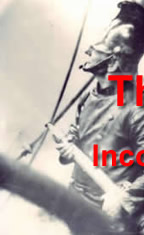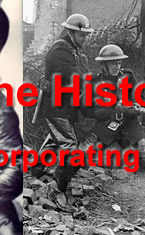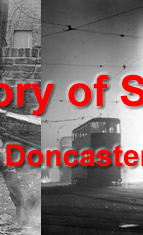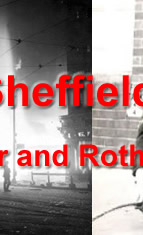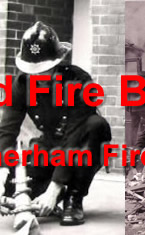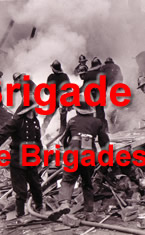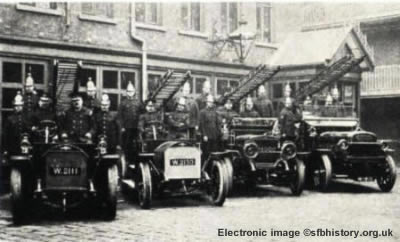
Following Superintendent Pound's retirement in 1895, 28 year-old William Alfred Frost was appointed Superintendent in Charge of Sheffield Fire Brigade. William was born in Rochdale, Lancashire, in 1867. He was the son of Alfred Frost, a police constable and Hannah Frost who was born in Ireland.
At the age of 14 in 1881 he commenced work as a Railway Clerk at Wardleworth, Lancashire. After serving 2 years 6 months in the Royal Artillery, serving in Gibraltar he joined Birmingham Police Force on the 12th April 1887 as a Police Constable.
On the 16th July 1890 he married Emma Swain, at St Mary's Church Rochdale. In the church marriage register he gave his occupation as Police Constable. Prior to his employment with Sheffield Fire Brigade he obviously rose through the Police/Fire Brigade ranks in Rochdale in order to be appointed to the rank of Superintendent.
The New CFO's Report:
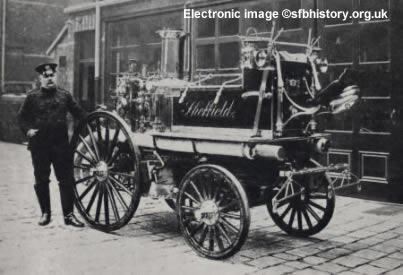 |
Superintendent Frost, in his first report, said that he did not feel the equipment of the Brigade would be complete until he had alarm boxes fixed at various points in the suburbs of the City. He also said that much time would he saved in receiving a call "if the larger works and shops had a wire and electric bell direct to the Station". In 1896 various items of equipment were purchased and a 45 ft. fire escape was stationed at Moorhead instead of at the Fire Station. On November 9th 1896, a ladder of flexible steel was tested as a fire escape. It is not known if it passed its test or not but here were the beginnings of awareness of alternative ways of escape in case of fire. In his report for 1899 Superintendent Frost reiterated his recommendations about the alarm boxes in the suburbs of the City. |
| The Chief Officer standing by a steam driven fire pump Photograph from: Sheffield Fire Brigade - A Brief History |
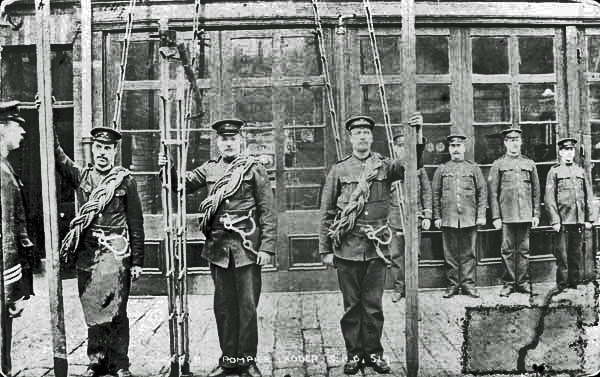 |
| Police Firemen drilling with Sapeur Pompier Ladders, Rockingham Street Fire Station, late 1800's. Photograph courtesy of John Hague |
The CFO's 1896 Report
In January 1897 CFO Frost offered his report on the work of the Brigade to Chief Constable J. Jackson.
In summary his report contained the following:
"The fires in Workshops and Manufactories numbered 47, in dwelling houses 31, Sale Shops 20, breweries and public houses 5, Stables and outhouses 5, Farms 4, timber yards 2, hay and straw stores 1, foods 1, Theatre 1, and Building in course of erection 1.
One fire occurred in the City at which life was lost, at the dwelling house No. 86 Broad Lane, on the 9th May. Hannah Gasgoine was found by the Brigade in the Kitchen burnt to a cinder. The origin of the fire was the exploding or dropping of a paraffin lamp.
The Firemen and Engine were engaged at fire 105 hours and 48 minutes, an average of 55.68 minutes at each fire – the time being taken from receiving notice to men and Engine returning to the Fire Station.
The Steam fire engines have been turned out to 17 fires and worked at 7 with good results.
The six horses belonging to the Department are healthy and in good working condition. Two horses have been purchased during the year, and one was sold having become unfit for the work.
During the year a new combined tender escape, 1,000 yards of hose, 34 pairs of couplings, 8 standpipes and 6 branches have been added to the equipment of the Brigade. The hose boxes attached to the Escapes at Millhouses and Neepsend Police Stations are now fitted with the necessary appliances. A 45 foot Escape has been stationed at Moorhead instead of at Fire Station as formerly.
The horse ambulance Carriage which is kept at this Station has been turned out 55 times, occupying 59 hours and 36 minutes or an average of one hour and five minutes per journey."
1896 Plans for a new Fire and Police Station at West Bar are made
March 1899 Sergeant Crawford Retires
Sergeant Crawford, formerly second officer in command of the Sheffield Fire Brigade, retired from the police force after 30 years’ service. On the 20th April 1899 he received of two handsome presentations. The first was handed to him at the headquarters of the Fire Brigade, in Rockingham Street, and consisted of a star pendant, bearing on one side the inscription, “Presented to Sergeant E. Crawford by the members of the Sheffield Fire Brigade, as a mark of esteem, on his retirement after 30 years service. March 1899,” and on the other side a miniature steam fire engine. This gift was handed to the ex-fireman by the Chief Constable (Commander Scott), in the presence of the members of the brigade. The presentation took place in the yard, and a suitable background was formed to the gathering by different engines, fire escapes, and other fire appliances. The Chief Constable, in making the presentation, spoke in high terms of Crawford’s services to Sheffield, and this appreciation amid the applause of the men, was backed by Superintendent Frost, the chief of the Brigade - The ex-sergeant made a most appropriate reply. The next presentation took place at the Central Police Offices, where Crawford was the recipient of a gold watch, given by the members of the Central Division. Last week Sergeant Crawford was the recipient of a gold chain, presented by the members of the Sergeants’ Association.
          |
| After the Fire circa 1900 - A group of Sheffield Firemen. Herbert Hague, (arrowed). Great-Uncle of John Hague (one of our researchers). |
News Report from: Sheffield Daily Telegraph Saturday, May 27, 1899
| NEW FIRE AND POLICE STATION, WESTBAR |
 |
This building is now being erected for the Corporation of Sheffield on a corner site at the junction of Westbar and Westbar Green. The elevation is designed in the eighteenth century Renaissance style; no portion is less than three stories high, and the length of the frontage is 55 yards. Welsh bricks are used fur the facing's,
and Scotch stone brought into requisition for the dressings. The tower rises to a height of 80 feet. The upper part is fitted up as a look-out from which any fire in that part of Sheffield may he seen, and its progress reported, and the lower part will be used for drying hose pipes up to a hundred feet in length.
The police department is to the left of the tower, and consists of waiting, charge, telephone, and search rooms, inspector's office, four cells, and a parading yard with a glass roof over, and stable for twelve horses. The fire department to the right of the tower will have the engines and one escape, stable for four horses, and a good house for the superintendent. The whole of the upper floor is arranged as bedrooms, with lavatory and bathrooms, for twenty single men, and the first floor has kitchen. dining. and recreation rooms for their daily use. White glazed bricks have been used for the walls of the fire engine house, police offices, and cells, and the floors will be of smooth surfaced concrete.
The general contract, is in the hands of Messrs. Ash, Son and Biggin, of Furnival Street, who have made good progress with the work, Messrs. Charles Chadwick and Sons have the slating and plastering; Messrs. Braithwaite and Co. the plumbing and glazing. Mr. Frank Tory the carving, Messrs. Bright Brothers the heating, the Gas Light Company is laying, on the gas, and the the building will also he fitted up with the electric light. The clerk of works is Mr. Walter Davion, and the architect Mr. Joseph Norton, of Alliance Chambers,Sheffield.
It is proposed to fit up the fire station with the latest known appliances to expedite a turnout, Immediately the alarm is sounded, the watchman rings simultaneously the call bells of all the men first for duty. If in bed their lights are switched on; the stables and engine house. doors, being fitted with a quick opening apparatus, are instantly released; the horses, always, standing, in the stables with their heads towards the engines trot forward to their places in the: shafts under the suspended harness, which is fitted with spring joints; the men, whether dining or reading on the first floor, or sleeping on the second floor dress and drop down by brass sliding poles info the engine house, and they can be clear of the station in a few seconds.
The building is expected to be ready for opening in August, and win form another of those welcome improvements on which the City Council are to he congratulated.
| 1900 Westbar Fire Station Opens - Sheffield now has two fire stations |
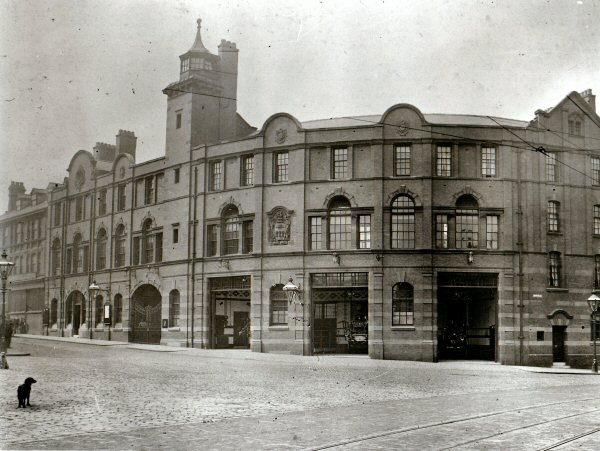 |
West Bar - Swinging Snap Harness for Horses:
Introduced by Superintendent Frost. Horses can be seen in stalls at rear of fire engine ready to move into position where alarm hells sounded. The picture shows the harnesses installed in the new West Bar Fire and Police Station. Immediately the alarm bells were sounded the horses standing ready in their stalls went and took their places in front of the appliances and one action sufficed to bring the harness into place and fasten it. This enabled the Brigade to turn out very quickly. This method of harnessing horses was first used by Firemaster Arthur Portage of Edinburgh Fire Brigade in 1903.
|
 |
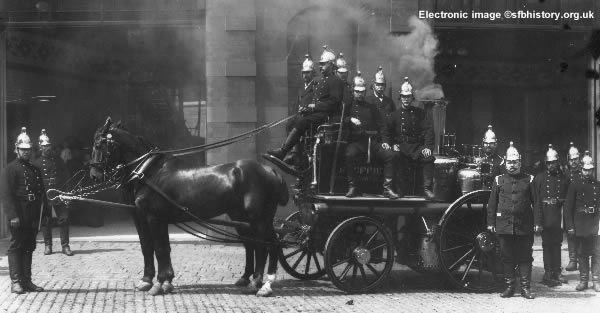 |
| A Horse Drawn Steamer outside West Bar Fire Station At this time steamers were the pumping appliances used by the brigade. Steam produced by the boiler was used to to power the pump. The pump was operated by an Engineer. Superintendent William Frost in the foreground. |
| Interior of West Bar Fire Station | Sheffield Police Fire Brigade at the Gallop: |
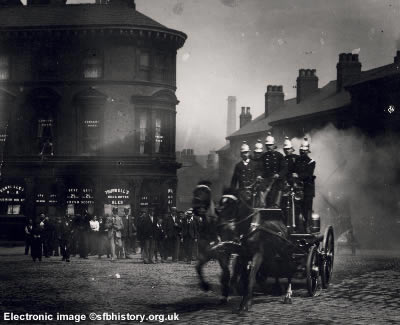 |
| Photograph of the Shand Mason Steamer Working during the same period |
          |
August 1900: An Unpopular Change to the Uniform
Extract from the Yorkshire Telegraph and Star
"During the last few months of the Sheffield Watch Committee, the Chief Constable, and the Superintendent of the Fire Brigade have been busily developing plans for the working of the new fire and police station in West Bar. The very latest appliances are at the station, and several entirely new arrangements have been introduced. Of the latter certainly the most striking is the uniform of those who are just joining the brigade. The orthodox brass helmet, belt and axe, jack boots, etc, have been rejected, and in their stead is the loose attire of the sailor. Most wearers, no doubt, would have to confess in the words of the longshoreman, “I ain’t no sailor bold, and I never was upon the sea,” but their Chief has spent some years on the ocean wave, and the novelty in uniform will doubtless recall to his mind happy days gone by. Several enquiries have been made already as to the meaning of the strange-looking men occasionally seen going through the town on a fire engine. Some have even suggested they are a new species of naval brigade. Certainly every one of them will be trained to be a handy man with the hose and ladder, but their general appearance when driving through the city inclines one to the belief that some ship’s company has broken loose and taken to strange ways."
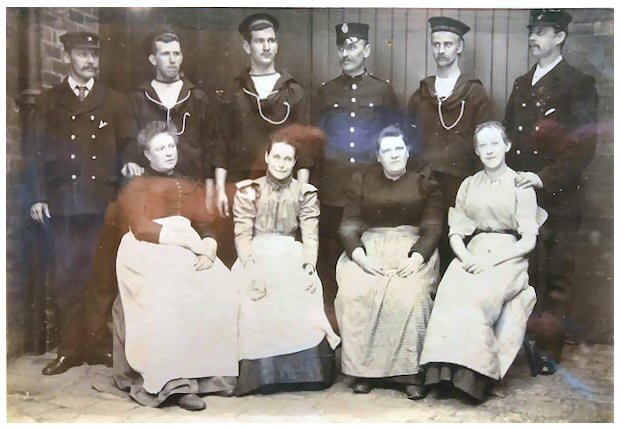 |
| 1900 The 'Very Temporary' Change of Uniform - Photograph courtesy of Nigel Kind |
1900 the City provides an Ambulance
Extract from the Yorkshire Telegraph and Star, 1st October 1900:
 "Many calls have already been made on the new ambulance van recently purchased by the Sheffield Corporation, and as proof of the necessity for such a vehicle, it may be mentioned that on Saturday it was requisitioned on no less than three occasions. In the first case it was taken out to remove a man who had fallen in a fit, in the second to the assistance of a man who had been badly crushed at Heeley, and in the last instance to convey a woman, who had taken a dose of carbolic acid, to the Hospital. In the possession of a first-class ambulance, Sheffield may be justly proud, but probably few people are aware that anyone is entitled to its use. It is kept at the head fire station in Rockingham Street, and upon the receipt of a message there regarding an accident, it is turned out, with a couple of trained men in charge, to any part of city. The ambulance is entirely at the disposal of the public, without any charge."In 1907... the ambulance calls amounted to no less than 2,691, and there were only two days of the whole 365 when the ambulance vans were not required. Saturday was usually the busiest day in this department, and in 1907, 526 calls were answered, the smallest number being on Sundays, viz, 232. In addition, the firemen undertook the removal of the bodies of persons fatally injured, suicides, etc., 184 cases being removed to the city mortuary in in the same year...
"Many calls have already been made on the new ambulance van recently purchased by the Sheffield Corporation, and as proof of the necessity for such a vehicle, it may be mentioned that on Saturday it was requisitioned on no less than three occasions. In the first case it was taken out to remove a man who had fallen in a fit, in the second to the assistance of a man who had been badly crushed at Heeley, and in the last instance to convey a woman, who had taken a dose of carbolic acid, to the Hospital. In the possession of a first-class ambulance, Sheffield may be justly proud, but probably few people are aware that anyone is entitled to its use. It is kept at the head fire station in Rockingham Street, and upon the receipt of a message there regarding an accident, it is turned out, with a couple of trained men in charge, to any part of city. The ambulance is entirely at the disposal of the public, without any charge."In 1907... the ambulance calls amounted to no less than 2,691, and there were only two days of the whole 365 when the ambulance vans were not required. Saturday was usually the busiest day in this department, and in 1907, 526 calls were answered, the smallest number being on Sundays, viz, 232. In addition, the firemen undertook the removal of the bodies of persons fatally injured, suicides, etc., 184 cases being removed to the city mortuary in in the same year...
To undertake ambulance work Firemen were trained by the St John's Ambulance Association.
To view a certificate issued to Fm Herbert Hague in 1912 please click >>here.
Annual Report - 14 March 1901
Supt. Frost's report of the work of the Fire Brigade for 1901 as issued on14th March 1901:
"The number of calls received was 193, an increase of four on the previous year. The figures include seven false alarms and 16 fires beyond the city boundary. Within the city 167 fires came under the heading “slight", the damage being under £1,000. The loss of property in-the city was £18,406, and beyond the city boundary £48,017. As compared with 1899 this was a decrease of £12,453 in the city, and an increase of £28,615 beyond the city boundary. There was a; increase of 68.3 calls on the average of the last ten years. The distance run to and from fires was 487 miles. Two fires occurred in the city in which life was lost. Eighteen members of the brigade were; injured whilst on duty.
The old manual engine taken over from the Insurance Companies' Brigade over 30 years ago has been sold to the Dronfield Fire Brigade. This was the last of the old hand engines possessed by the Corporation. A combined tender-escape, steam-engine, and tender, are on order, and when these are delivered the, Sheffield Fire Brigade will be second to none in the kingdom for thoroughly up-to-date equipment. Other interesting details are given, and Supt. Frost concludes: - Complaints are often made of the difficulty and time wasted in getting a call through to the Fire Station. The adoption of automatic alarms, both in the streets and important buildings would be a great boon and soon save the cost of installation."
1901 Establishment Rockingham Street Fire Station:
| 1 | Police Superintendent, Chief Fire Officer |
| 2 | Fire Engineers |
| 1 | Water Company Turncock |
| 17 | Police Constables/Firemen |
Download the abridged 1901 Census for Rockingham Street Fire Station (Opens on a separate page)
1901 Establishment West Bar Fire Station:
| 1 | Police Inspector/Fire Officer |
| 1 | Matron/Nurse |
| 19 | Police Constables/Firemen |
Download the abridged 1901 Census for West Bar Fire Station (Opens on a separate page)
May 1901 The Creation of Fire Tanks
On the 14 May 1901 according to the Sheffield Star
"An interesting experiment was conducted in Arundel Street, by the Sheffield Fire Brigade.With a view to preventing the waste of water which occur at large fires under the present conditions of working, the corporation have recently placed an underground tank in Arundel Street, which is filled with water from the mains. Should a fire of any proportions occur in the vicinity the steam fire engines will be served from this tank. The portable canvas reservoir will thus be superseded. The supply of water to the tank can be regulated by the turncock throughout the operations – an advantage which under present conditions is not possible – and it is claimed that this will considerably reduce the amount of water drawn from the mains when a big fire is in progress. It is intended to place tanks of a similar kind in other districts, where big blazes may be look for. There was a large gathering to witness the experiment. Two engines were requisitioned. The combined efforts of both were devoted to throwing a single jet of water which rose to a height of some 50ft in splendid fashion. The inflow of water to the tank was under control throughout, and the advantages of the innovation were amply demonstrated. The ordinary canvas reservoir was then brought into use, thus showing the comparison between the new method and the old. On the face of it, these tanks seem to be an ingenious device for the saving of water, but it is obvious that a very large number of them will have to be laid down if any material results are to be obtained, simply on account of the fact that one never knows where a big fire is going to occur."
(These tanks were eventually placed at strategic points throughout the City Centre, Attercliffe and Darnall. They came into their own at many large fires, and were used in the Sheffield Blitz. The last use of one of these tanks was at the Wigfall's Shop fire, Fitzalan Square, in the early 1980's. Shortly afterwards they were all decommissioned and filled in due to lack of maintenance.)
June 1901 Engineer Abraham Brookes retires
he was first skilled mechanic employed in the Sheffield brigade. During his long term of service he has attended nearly all the big fires in the district. For the last few years he had been in charge of the call office during the day and at all times was reported to have done conscientious service. His fellow firemen purchased a nickel silver smoker’s companion, upon which was engraved the following inscription – ‘Presented to Engineer Brookes by members of the Sheffield Fire Brigade on his retirement on pension after 25 years’ service, June 3, 1901'.
November 1901 - Water Supplies at Lodgemoor Hospital
On the 7th November 1901 Supt. Frost reported to the City Hospital Committee that on Wednesday, the 23rd October, he, in the presence of- the Chairman of the Hospital Committee and Mr. L. S. M. Marsh, practically demonstrated that the water conduit near Lodgemoor Hospital is within working distance of that Institution. The small steam fire engine having a capacity of 350 gallons per minute, threw a very good fire-fighting jet over the new Hospital buildings. In case of an actual fire he could work three lines of hose from the engine, having 3 good jets of ¾ inch each, and the engine would be throwing over a ton and a half of water per minute on the fire. As every moment is, of course, of great value at the commencement of an outbreak, it is very necessary that hydrants should be placed in suitable positions; to be used is a “first get to work." In case of his Brigade receiving a call he should work from the conduit at once, leaving the Hospital staff to use the hydrants. Supt. Frost continued – I shall strongly recommend, in due course, that a small brigade be formed from amongst the staff, and every person to be instructed in the use of the fire appliances. At present every man about the Hospital can use the appliances, and at the recent fire got to work splendidly, but I would also have the maids and nurses trained to act as “firemen”.
Out of Area Charges 4 December 1901
On the 4th December 1901 the Sheffield Watch Committee fixed the scale of charges for the attendance of the Fire Brigade at fires outside the City boundaries. The Scale was as follows:
For the turnout of the engine £4, £2 per mile travelled, £8 for the first hour's working, and £6 per hour afterwards; for the services of the Superintendent 3s. for the first hour, and 1s. 6d. for each subsequent hour: for the services of each other fireman, 2s. for the first hour, and 1s. per hour afterwards.
1902 Fire Alarm Boxes
In 1902 Mr. Frost stated that the need for an up to date fire alarm system was badly felt by the Brigade. Fifty-three calls had been received by messengers running to Fire Stations during the year. This was obviously a waste of valuable time as every second was of importance at the commencement of a fire and the losses could be still further reduced when fire alarm boxes were fixed near to important risks.
9th August 1902
The Watch Committee approved the purchase of a full size, second-hand, billiard table for use by the firemen at Rockingham Street, Fire Station in the recreation periods.
Yorkshire Telegraph and Star, 11th December, 1903
Incorporating the Sheffield Times
An Argument Erupts between the Watch Committee and Sheffield City Council regarding Fire Alarms in the City and the dangerous delays when summoning Fire Appliances:
Councillor Davison, when he spoke at the Sheffield Council meeting on Wednesday with reference to the need of a proper system of fire alarms in the city, and did not lay too much emphasis on a state of affairs almost akin to a public scandal. Sheffield has one, of the most efficient fire brigades in the kingdom but the facilities which it is afforded for saving life and property are in some important details less than are to be found in places a little more than a tenth its size. This has been recognised not only by the members of the brigade; but the Watch Committee also. As Councillor Davison put it, "the Council will awake to a sense of its duty some morning, when the city meets with one of those catastrophes which have occurred in other towns"; in other words' when, through lack of means of communication with the fire station, life and property have been sacrificed.
Unless a resident has a telephone, he possesses no means of communicating directly with the station and, the members of the Fire Brigade are able to quote cases whore serious results have followed the delay caused through messengers having to cover long distances before getting into touch with them. Nearly two years ago this matter was brought officially before the Watch Committee by the Chief Constable. (Commander Scott). He gave specific cases showing the longest distances, messengers travelled in consequence of a telephone not being available. His return for 1899, 1900, and 1901 shows that persons actually covered from a half to three miles within the city boundaries after an outbreak of fire.
No parsimonious policy should stand in the way of a remedy which has been adopted in towns, large and small, throughout the country. Probably it would be no exaggeration to say that in the means which are afforded to the public for getting into communication with the fire brigade, there is no important city or town in the kingdom in such a deplorable position as Sheffield The, situation is a nightmare to the responsible officers of the brigade; the Watch Committee have tried to induce the Council to erect alarms in various parts of the city, so that a resident might know immediately where to go, and indicate to the fire station the locality of a fire. But their action has been in vain. Different systems are at work in the country; but the Sheffield City Council are apparently waiting for proof of the necessity of such an installation; no doubt, it will he forthcoming one morning, and what. Council Davison describe as the “amateur professionalism” in connection with this question will receive its death blow.
But the question is whether the citizens are prepared to wait for such a ride awakening. It is nearly two years ago that the Chief Constable visited Bradford, and made a report to the Watch Committee on what is known as the Gamewell “police and fire alarm.” He pointed out that it would be found wholly adequate to the requirements of the Sheffield Police and Fire Departments. In addition, he stated the Tramways Department would find the system useful in sending reports of occurrences in connection with their duties. The following he mentioned as amongst its principal and most important points of value. “Calls to fires, for ambulance, hearse and other vehicles worked by the Fire Brigade, could be sent to the Fire Station much quicker, particularly after business hours, when telephones are not easily accessible. It would give every citizen the means of instantly summoning the Fire Brigade or police. It would afford the opportunity to convey to the police station, in a properly constructed wagon, the uproarious drunkard or street brawler, without the lamentable exposures which are now only too often seen in our main streets. It would also be the means of calling assistance in case of riot or disorderly assembly. It would increase the power of the police officer, and could be used by him to communicate quickly with the Central Police and Detective Offices. Police officers in the outlying and scattered parts of the city would be required to report themselves during their tour of duty thus increasing the efficiency and discipline of the force.”
The telephone system in connection with the tramways might be utilised in the installation of an alarm system, and after considering the report of the Chief Constable, the Watch Committee recommended an expenditure of £475 for the supply and erection of the Gamewell fire alarm point in the Tinsley district. But the Finance Committee declined to sanction the expenditure, and the unsatisfactory state of affairs continues to exist. That such a parsimonious policy should 'be allowed to prevail when life and property are at stake must be regarded as deplorable, particularly when governing authorities in much smaller towns have recognised their responsibility in this matter.
An interesting test of a new fire alarm apparatus:
An interesting test of a new fire alarm apparatus was made in Sheffield yesterday at the printing works of Messrs. Pawson and Brailsford, Mulberry Street. The members of this firm, profiting by their sad experience in the early part of the year when they suffered to a serious extent from a fire, have made ample provision, in case their premises should be so at attacked again, for the flames to be discovered and got at without the slightest delay. They have had installed the May-Oatway automatic fire alarm, a simple but ingenious contrivance for raising an alarm in case of an outbreak. The abstract principle is not new; it is simply the compensated balance of a watch adapted to a new and important use. There is a copper wire, coupled to a steel guard, the shape of which is determined by the calculations necessary to give approximate uniformity of expansion and contraction at an ascertained ratio of speed. The combination is adjusted to give the alarm at a given number of degrees above the normal, and when this margin is set it is automatically maintained, and does not require to be varied. The wire and its compensator are mutually self-adjusting, lengthening with every ordinary rise and shortening with every fall in temperature, but in the centre of the pair or the position of equilibrium (adopted in this system for the purposes of contact) there is no move – except in the case of fire, when the detecting wire lengthening rapidly establishes contact and give the alarm – and the margin is set faithfully maintained under any and every normal change of temperature.
In case of a sudden rise in the temperature, as in case fire, bells ring in different parts of the building to warn employees, and an indicator in the time office shows on which floor the fire has broken out. This is important, but far more important still is the alarm that is given at the Fire Brigade Station simultaneously with the ringing of the bells in the place. The firemen, therefore, receive the call over the specially constructed wire without the slightest delay.
Messrs. Pawson and Brailsford have 50 of the alarms fixed in their Mulberry Street premises - the first, in Sheffield - and the exhibition yesterday was a decided success. In the Chief office a tank of methylated spirit was ignited and allowed to burn. At the end of 93 seconds the temperature had risen sufficiently to make the electric connection. The alarm bells at once rang, and at the same time the special bells gave the alarm at the Rockingham Street and Westbar Fire Stations. From these places there came galloping two tenders and a steamer with a full compliment of men and their arrival on the scene in two minutes and ten seconds after the alarm sounded was at once a tribute to the expertness of the Fire Brigade and to the efficacy of the apparatus.
In 1903 a new Fire Escape was purchased
The telescopic ladders were extended by an engine fixed at the end and at the side of the main ladder, power being provided by carbonic acid gas which was stored in four cylinders ready for use. This escape was a fore-runner of the modern Turntable Ladder, and had many interesting automatic devices attached to it. One of them was an arrangement for throwing the engine out of gear when the ladders were fully extended, the gas escaping from the safety valve fixed on the feed pipe. An indicator was provided on the foot of the ladders showing the height to which it was raised and there was an oil brake for lowering the ladders. A plumbing gear was also incorporated to enable the ladders to be maintained in a perpendicular position irrespective of the position of the carriage. This escape having an engine and two extending ladders was the first of its kind in the Country.
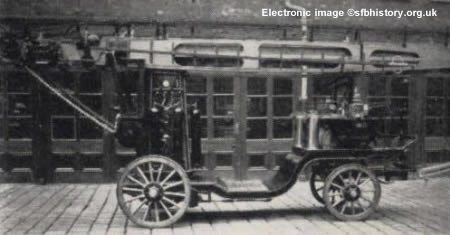 |
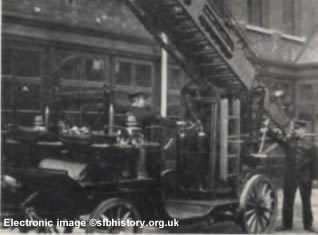 |
|
The horse drawn 75ft turntable escape, made by "BRAUN" of Germany, was brought into service in 1903, and motorised in 1925. It continued in service until 1928. |
The ladders were extended by carbon dioxide gas and the fireman can be seen opening the control valve on one of the gas cylinders. |
Fire at Birley East Colliery On January 25th 1904 at 2.30 pm; A major fire developed in the engine room at Birley East Colliery, which was very quickly consumed; it spread rapidly to the dynamo room and downcast shaft; the dynamos were destroyed in the process. Consequently, the woodwork in the shaft was ignited and smoke and flames were spreading down the shaft. The fire started as the day shift and afternoon shift were changing over, when some men had already descended into the pit to start the afternoon shift, whilst others from the day shift were still in the pit waiting to be brought to the surface. It was feared that all the 1050 men may be trapped underground, and relatives began assembling on the pit top, fortunately their fears were suppressed by the management who gave them reassurances that everyone was safe. The Sheffield fire brigade sent a horse drawn steamer, which was soon on the scene and after a while, the fire was sufficiently under control to allow the men to be wound to the surface. The fire brigade remained at the colliery overnight damping down. and left the pit at 9 am. the following day. The pit was closed for two weeks and suffered damage estimated to be in excess of £10,000. (Story courtesy of Ken Wain) |
In 1905 Sheffield Fire Brigade had 9 stations
          |
| Image courtesy of John Hague Sheffield Fire Brigade Horse Drawn Appliances 1905 |
The 1905 Fire Brigade Establishment
| Rockingham Street Fire Station | West Bar Fire Station | Attercliffe Police Station |
| 2 Horse Drawn Shand Mason Steam Engine 1 Horse Drawn Steam Engine 1 Horse Drawn Escape 3 Horse Drawn Hose Tenders 2 Escapes |
1 Horse Drawn Shand Mason Steam Engine 1 Horse Drawn Braun 75’ Turntable Ladder 1 Horse Drawn Hose Tender 1 Escape |
1 Reel Cart |
| Brightside Police Station | Broomhill Police Station | Highfields Police Station |
| 1 Escape | 1 Reel Cart | 1 Reel Cart |
| Millhouses Police Station | Neepsend Police Station | Walkley Police Station |
| 1 Reel Cart | 1 Reel Cart | 1 Reel Cart |
| Establishment: 27 | 1 Superintendent, 1 Sergeant, 2 Engineers, 2 Coachmen, 21 Firemen |
Above information Supplied by Simon John Ryan
New Fire Call Record Set in September 1906
During the history of the Sheffield Fire Brigade up to the commencement of September, the highest number of fie calls received during one month was twenty-nine. Now a fresh record has been set up. Forty-one calls were made during September. The average damage per month caused by fires attended by the Sheffield Brigade during the last twenty years is over £1,800. In one year 1893, the average damage per month was over £5,725. By way of contrast, the damage during the whole of the following year was only £3,661.
Also in 1906 - Sheffield Fireman's Appointment
18th December, 1906, at a meeting of the Barking Town Urban District Council Engineer G. Galloway, of the Sheffield Fire Brigade, was unanimously appointed chief fire officer of the Barking Town Brigade. Engineer Galloway succeeded another ex-Sheffield fireman in Mr Farmery, who had been appointed to the Port Sunlight brigade of Messrs. Lever.
1906 the Lowest Fire Loss for Ten Years
Sheffield suffered a smaller loss from fires during 1906 than in any of the past ten years. The annual report of the Chief Officer Frost of the Fire Brigade, stated that the damage to property occasioned by fires they attended was £17,661 below the average for that period. The highest amount was £66,424 in 1900, the lowest £7,859 for the past year, and the next smallest total £8,330 in 1902. The total number of calls to fires, or supposed fires last year, was 238, an increase of one on the previous year. Within the city 222 were slight and only one serious (where the damage exceeded £1,000).
The brigade responded to calls not only from the city, but from the whole of the surrounding district and the difficulty of collecting charges from places outside the city boundary the City Council decided to serve only such districts that entered into proper arrangements with them. As a consequence of arrangements made with the parish councils of Tinsley, Norton, Staveley, and Handsworth, and a good number of private persons and trading concerns.
The brigade maintains two ambulances. It also provides firemen to take duty on the stage, during performances at the Lyceum Theatre, Theatre Royal, Alexandra Theatre, Attercliffe Theatre, and the Empire Theatre.
The losses within the city amount to £7,494 14s 6d. the six outside Sheffield £364 10S. Compared with 1905, the total of £7,859 4s. 6d showed a decrease of £3,048 10s on the amount of property destroyed within the city, and a decrease of £1,017 10s on that outside the city boundary. Five fires occurred in Sheffield in which life was lost, and the number of lives actually at risk was 135. On six occasions families were rescued or escaped by way of bedroom windows, serious injury resulting in some cases. No fewer than 7,130 hours were spent by firemen on duty at the theatres and music-halls.
The number of calls received for the ambulance during the year was 2,475, and increase of 226.
Yorkshire Telegraph and Star, 1907
FIRE BRIGADE HORSES V. MOTOR TRACTION
"Sir, - On Thursday evening in “Round the City” you make a reference to a report of the Chief of the Fire Brigade as to the value of the motor now in use by the Fire Brigade, and assert that the day of the brigade horse is over. Heaven forbid such a calamity. May I ask the simple question: Has the horse ever failed to reach a fire through the horse breakdown. If the horse does breakdown, there are so many on the road that it can soon be replaced, and the Brigade can go on its mission, but let the motor break down, the same as it has done this morning on its way to Kenbourne Road, it has to stop whilst it can be replaced. It makes one shudder to think if the fire had been in the early hours of the morning with this motor stuck in the road as it was.
No sir, I venture to say the good old creatures, the horses, days are not over. This incident alone tends to show their value to the public more than ever. If they are not quite so fast, they are sure, and that's what we want. - Yours, etc.,
THE HORSE IS NOT DEAD YET.
Upperthorpe, Feb. 26
The First Motorised Fire Appliance
In 1907 the first motor escape was purchased and was an unqualified success, Forty-four fires were attended by this appliance and the Superintendent in his Annual Report stated that its superiority over horses was very marked. The steep gradients were easily negotiated and the scene of the fire was reached in half the time taken by the horses. The engine was started up every few hours both day and night to facilitate turning-out. The appliance lights powered by using acetylene gas which was carried already generated by means of dripping water into calcium carbide and by means of a sparking plug in each lamp the lights on the appliance were lit by turning a switch.
Photograph from: Sheffield Fire Brigade - A Brief History |
| In 1907 First motor fire engine purchased, registration No. W.1000. The other appliances shown were still horse drawn. |
1908
In 1908 the number of men was increased from 27 to 40. This was brought about by Firemen commencing duty at theatres and a sum of 30/- per week was charged to the theatre proprietors. In 1909 the Superintendent was able to report that the motor escape had done more work than all the other appliances put together; that the loss of life and property had thus, by motor traction, been reduced to a minimum; and that if the record was to be maintained it was necessary that another motor driven appliance be purchased. He said he was very loath to revert to the use of horses.
In 1908 the following rules relating to Theatre Duties were issued to Fireman Herbert Hague (Courtesy of John Hague)
Fireman No. 1
City of Sheffield, Fire Department, Head Quarters, Rockingham Street
1st February 1908
Rules and Regulations to be observed by Firemen on duty at the Theatres
| 1 | The parade will be ordered daily in time to allow each Fireman to commence duty one hour before the performance commences. |
| 2 | The Senior Officer in the Station at the time will parade the men and if necessary correct any negligence in attire, want of cleanliness or neatness and make an entry in the book (duty) of the time of each man leaving the Station. |
| 3 | Firemen in uniform when going to and from a Theatre or any other duty are not allowed to smoke in the Streets. |
| 4 | Immediately on arrival at the Theatre he will report by telephone to the Chief Station, and any Fireman loitering will be call upon for an explanation. |
| 5 | He will at once proceed to examine the whole building and see that all the doors are free from obstruction and in working order, he will be the competent person mentioned in section (19) and immediately after the inspection will record the same in the log book which will be kept at each Theatre, any usual occurrence or visit of any Officer of the Fire Department, Police or any member of the Stage Plays Committee or Watch Committee of the city council will also be entered. |
| 6 | On completion of his tour of inspection and before the commencement of the performance he will take duty on the stage and will not on any account other than urgent necessity, when a report of the same must be made, visit the auditorium or leave the building except to see that the requirements, paragraphs 7 and 8 are properly observed. |
| 7 | He will lay out the hose pipes with branches properly connected and see that all scenery and other properties are kept clear of them. |
| 8 | He will see that the emergency doors and all other exits are used at the close of each performance. |
| 9 | He will not converse with persons other than is absolutely necessary, and his deportment should be of an Officer like character and such only as will reflect credit on the department. |
| 10 | Should a fire break out he will at once act as necessary always sending a man immediately to telephone the call to the Fire Station. |
| 11 | Visiting the “Theatre Bars” on any pretence whatever “Public Houses” either going to or returning from duty will meet with dismissal. |
| 12 | After the performance is over he will thoroughly inspect the premises and ring up to the Chief Station when leaving reporting all correct or otherwise. |
| 13 | The sections of the rules and regulations made by the Stage Plays Committee which affect firemen are given below and the man on duty must see the instructions are properly carried out. |
| 14 | It is suggested that the management of each Theatre form the permanent members of his staff into a Theatre Fire Brigade who would act under the orders of the city fireman for the time being in charge and the Theatre Fire Brigade should be inspected from time to time by the Chief Officer of the City Fire Brigade. |
(Signed) Chas. T Scott
Chief Constable
Extracts from the rules and regulations made by the Stage Plays Committee of the Town Council on the 29th February 1892
Licensing |
Pursuant to the provisions of the status in that behalf with regard to Theatres within the said borough and adopted by the Town Council on the 9th March 1892. |
Section 5 |
That every Theatre will be closed to the public not later than half past eleven o’clock every night during the week. |
Section 15 |
That all gas taps shall be guarded and where possible out of the reach of the public in the passages, stair cases and other parts of the Theatre to which the public are admitted. That all moveable and occasional lights be protected in the same manner and be under the charge of responsible for light watching, and extinguishing them. That the service of lights for the auditorium and entrance or exit passages be separate from the stage. That natural rubber or Gutta Perchia gas pipes be used in the building except for temporary movable lights about the stage, no shall any white metal gas pipes be used unless embedded in the walls, that all gas pipes be of Iron or Brass except as aforesaid. |
Section 16 |
That the hose shall be kept in readiness at all times during the performance to connect with the water plug inside the building, and buckets shall always be kept ready filled with water behind the scenes, that with blankets or rugs be kept in the wings and attention directed to them by placards legibly printed or painted and fixed near them, and that some persons be responsible for keeping the blankets and buckets ready for immediate use. |
Section 17 |
That Hatchets, Hooks or other means to cut down hanging scenery in case of fire be always in readiness and the Flymen be instructed in their use. |
Section 18 |
That the regulations for extinguishing fire be posted in conspicuous places so that all persons belonging to the Theatre may be acquainted with their contents. |
Section 19 |
That a competent person or persons be appointed to examine before every performance the exits, staircases and fire extinguishing apparatus, and that he or they enter and sign a report daily in a book kept for that purpose, such books to be kept open to the inspection of the Superintendent of the Fire Brigade at all reasonable times. |
Section 20 |
That the fire proof curtain be raised and lowered down to the floor at least once each evening during the performance and that the stage doors in the proscenium be kept in proper working order. |
Section 21 |
That during the time when a Theatre is open to the Public all the approaches, staircases and passages within the building shall be kept entirely free from obstruction and that no seats whether movable or otherwise shall be permitted on any gangways, alleys or passages within that portion of the building set apart for the spectators. |
Section 22 |
That all doors and barriers shall open outwards and never be fastened during the time when the Public is within the Theatre. |
Section 23 |
That all the means of exits shall be indicated in the several parts of the Theatre by printing placards in plain characters in conspicuous places. |
1908 Ambulance Duties - Procedure
Firemen performing ambulance duty will carefully note the following instructions.
When a patient is suffering from any injury where a question of crime including suicide may be involved he should in the absence of the Police take possession of any Weapons, Poisons or vessels having contained such poisons, and be very particular that such articles are not handled unnecessarily.
In the more serious cases where death has already ensued the body and surrounding objects should not be disturbed or allowed to touched as that finger prints other than those already impressed on them may not appear on any object whatever and valuable evidence thereby destroyed. On the arrival of the Police he will take his instructions from them.
The Officer on duty at the Central Police Office will be immediately informed by the telephone on the return of the Fireman as to the nature of the case, a written report giving full particulars and an account of all monies and other property found on any patient together with a note as to where the patient or body was searched, in whose presence and to whom the property was finally handed, will be dispatched to the Police Officer at the earliest possible moment.
The Fire Brigade officer on duty will make themselves aquatinted with ever case on the return of the Van and that the Ambulance duty is properly performed.
Chief Constable Office signed
Charles T. Scott
1.1.08 Chief Constable
William Frost
Superintendent
1910 A New Motor Fire Engine
In 1910 the fleet was expanded when a new Motor Fire engine was in fact purchased and placed in commission in December. It had a six-cylinder petrol engine and according to the R.A.C. formula was of 72 horse power. It had a centrifugal pump capable of delivering 450 gallons of water per minute and carried a 36 ft. extending ladder. Also in this year a new apparatus was purchased enabling firemen to enter buildings Filled with smoke. It consisted of an oxygen cylinder charged to a pressure of 120 atmospheres. The oxygen was supplied to the fireman's helmet. The exhaled breath was to some extent purified by contact with a regenerator which contained layers of caustic potash. This apparatus proved very useful on the occasion of a cellar fire, when the firemen were able extinguish a very difficult outbreak by its aid.
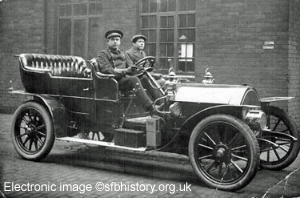 |
Photograph courtesy of John Hague |
1911 - A Snapshot in Time:
In 1911 the brigade consisted of 40 firemen and 2 Turncock's. They were all sworn in as policemen, but only 6 actually ranked as police officers, and were partly maintained by the Imperial Exchequer. The maintenance of the others was defrayed entirely to the Corporation out of the district fund. The brigade at that time cost between £4,000 and £5,000 per year. At this time Superintendent William Frost, was the chief officer, and Superintendent Frederick William Hadwick, was the second officer and had charge of the Westbar Station, with the third officer Inspector John Robert Corlett and the fourth officer, Sergeant Fred Outram were based at the Chief Fire Station, Rockingham Street.
1911 Establishment Rockingham Street Fire Station:
| 1 | Police Superintendent/Chief Fire Officer |
| 1 | Police Inspector/Fire Officer |
| 1 | Police Sergeant/Fire Officer |
| 1 | Police Constable/Fire Engineer |
| 16 | Police Constables/Firemen) |
| 1 | Coachman |
| 1 | General Smith/Farrier |
| 1 | Blacksmith |
| 1 | Motor Driver |
View the Abridge 1911 Census for Rockingham Street Fire Station (Opens on a separate page)
1911 Establishment West Bar Fire Station:
| 1 | Police Inspector (Second Officer) |
| 1 | Matron |
| 2 | Fire Engineers |
| 24 | Police Constables (Firemen) |
View the Abridged 1911 Census for West Bar Fire Station (Opens on a separate page)
Researched by Ted Mullins from the 1911 Census - February 2024
1911 The Motorised Fleet
|
|
Two further motor chassis were purchased in 1911, and these were fitted with bodies by members of the Brigade. During the year one horse had died and two had been sold to the Cleansing Department. The remaining four were still in good condition, evidence of the care taken by the Firemen in charge of them. About this time a number of fires were occurring in the Cinemas of the City, mainly through the film being jammed in the gate of the projector.
In 1913 whilst returning with a Steam Fire Engine, From a fire, the chestnut horse "Buller" dropped dead in Waingate. This horse was a handsome animal with a silver mane and tail and was a familiar sight in the City. It was believed that the cause of death was through the bursting of a blood vessel.
On 12 December 1913, Fireman Herbert Hague resigned from the Sheffield Fire Brigade. A copy of his resignation letter is downloadable from >here<. Herbert went on to fight in the great war, and survived.
In 1914 the property adjoining the Fire Station in Rockingham Street was purchased with a view to future extensions and four of the houses were put into good habitable condition and accommodated Firemen. On the outbreak of war in 1914, eight men were recalled to the colours.
In 1915 Superintendent William Frost retired.
